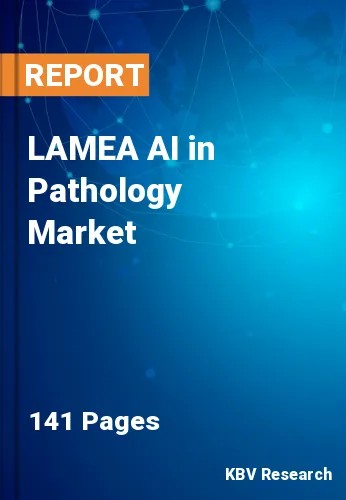The Latin America, Middle East and Africa AI in Pathology Market would witness market growth of 19.0% CAGR during the forecast period (2023-2030).
AI contributes to predictive analytics by analyzing patient data and pathology images to forecast disease progression and outcomes. This application is particularly relevant in cancer pathology, where predicting the aggressiveness of tumors and patient survival rates can guide treatment decisions and personalized therapeutic strategies. Pathology research often involves the analysis of vast datasets of histopathological images. AI-driven image analysis accelerates this process, enabling researchers to identify relevant patterns, biomarkers, and associations within the data. This has profound implications for understanding disease mechanisms, drug discovery, and expanding novel therapies.
Moreover, AI in pathology enhances quality assurance by standardizing the interpretation of pathological images. Automated algorithms can reduce diagnosis variability, ensuring consistency and reliability across laboratories and pathologists. This standardization is critical for large-scale clinical trials, where uniformity in pathology assessments is essential. Integrating AI into pathology workflows optimizes processes by automating routine tasks like slide scanning, image analysis, and report generation. This accelerates turnaround times and allows pathologists to concentrate on more complex and subtle aspects of diagnostics, fostering a more efficient and productive working environment.
Some countries in the region face a higher burden of infectious diseases. AI in pathology could be instrumental in diagnosing and managing diseases like tuberculosis and malaria. With urbanization and lifestyle changes, there is a rising incidence of non-communicable diseases. As a result, these aspects will boost the market growth in the coming years.
The Brazil market dominated the LAMEA AI in Pathology Market, By Country in 2022, and would continue to be a dominant market till 2030; thereby, achieving a market value of $1,114 Thousands by 2030. The Argentina market is showcasing a CAGR of 19.6% during (2023 - 2030). Additionally, The UAE market would register a CAGR of 18.6% during (2023 - 2030).
Based on Neural Network, the market is segmented into Convolutional neural networks (CNNs), Generative adversarial networks (GANs), Recurrent neural networks (RNNs), and Others. Based on Application, the market is segmented into Drug Discovery, Disease Diagnosis & Prognosis, Clinical Workflow, and Others. Based on End User, the market is segmented into Pharmaceutical & Biotechnology Companies, Hospitals & Reference Laboratories, and Academic & Research Institutes. Based on Component, the market is segmented into Scanners, and Software. Based on countries, the market is segmented into Brazil, Argentina, UAE, Saudi Arabia, South Africa, Nigeria, and Rest of LAMEA.
Free Valuable Insights: The Worldwide AI in Pathology Market is Projected to reach USD 66.3 Million by 2030, at a CAGR of 15.8%
The market research report covers the analysis of key stake holders of the market. Key companies profiled in the report include Koninklijke Philips N.V., F. Hoffmann-La Roche Ltd., Hologic, Inc., Visiopharm A/S, Paige AI, Inc., PathAI, Inc., Aiforia Technologies Plc, Indica Labs, Inc., Optrascan, Inc. (Optra Ventures, LLC), MindPeak GmbH.
By Neural Network
By Application
By End User
By Component
By Country
Our team of dedicated experts can provide you with attractive expansion opportunities for your business.

